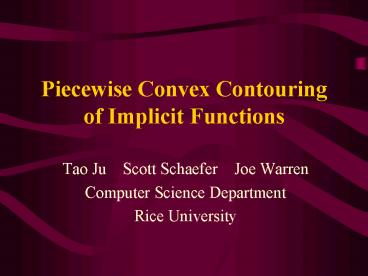Piecewise Convex Contouring of Implicit Functions - PowerPoint PPT Presentation
1 / 21
Title:
Piecewise Convex Contouring of Implicit Functions
Description:
Piecewise Convex Contouring of Implicit Functions Tao Ju Scott Schaefer Joe Warren Computer Science Department Rice University Introduction Contouring 3D volumetric ... – PowerPoint PPT presentation
Number of Views:67
Avg rating:3.0/5.0
Title: Piecewise Convex Contouring of Implicit Functions
1
Piecewise Convex Contouring of Implicit Functions
- Tao Ju Scott Schaefer Joe Warren
- Computer Science Department
- Rice University
2
Introduction
- Contouring
- 3D volumetric data
- Zero-contour of scalar field
- Marching Cubes Algorithm Lorensen and Cline,
1987 - Voxel-by-voxel contouring
- Table driven algorithm
3
2D Marching Cubes
- Generate line segments that connect zero-value
points on the edges of the square. - Partition the square into positive and negative
regions. - Connected with contours of neighboring squares.
4
3D Marching Cubes
- Generate polygons that connect zero-value points
on the edges of the voxel. - Partition the voxel into positive and negative
regions. - Connected with contours of neighboring voxels
5
Key Idea Table Driven Contouring
- Structure of the lookup table
- Indexed by signs at the corners of the voxel.
- Each entry is a list of polygons whose vertices
lie on edges of the voxel. - Exact locations of vertices (zero-value points)
are calculated from the magnitude of scalar
values at the corners of the voxel.
6
Goal
- Extend table driven contouring to support
- Fast collision detection.
- Adaptive contouring (no explicit crack
prevention).
7
Idea Keep Negative Region Convex
- Generate polygons such that the resulting
negative region is convex inside a voxel.
Non-convex
Convex
8
Fast Point Classification
- Bound the point to its enclosing voxel.
- Build extended planes for each polygon on the
contour inside the voxel. - Test the point against those extended planes.
Inside negative region
Outside negative region
9
Construction of Lookup Table
- In 2D, line segments are uniquely determined by
sign configuration. - In 3D, polygons are NOT uniquely determined by
sign configuration.
10
Algorithm Convex Contouring
- In 3D, line segments on the faces of the voxel
connecting zero-value points are uniquely
determined by sign configuration (table lookup). - Contouring algorithm
- Lookup cycles of line segments on faces of the
voxel. - Compute positions of zero-value points on the
edges. - Convex triangulation of cycles.
11
Convex Contouring
12
Examples using Convex Contouring
13
Beyond Uniform Grids
- Current work Multi-resolution contouring
- A world of non-uniform grids.
- In 2D Contouring transition squares between
grids of different resolutions
14
Beyond Uniform Grids
- Current work Multi-resolution contouring
- A world of non-uniform grids.
- In 3D Contouring transition voxels between grids
of different resolutions
15
Strategy Adaptive Convex Contouring
- Build expanded lookup table for transitional
voxels with extra vertices. - Polygons connected with contours from neighboring
voxels.
Transition Voxel 1
Transition Voxel 2
16
Benefits of Adaptive Convex Contouring
- Automatic method for computing table
- Fast contouring using table lookup
- Crack prevention
- Contours are consistent across the transitional
face/edge. No crack-filling is necessary.
17
Examples of Adaptive Convex Contouring
18
Examples of Multi-resolution Contouring
19
Conclusion
- Convex contouring algorithm.
- Fast Collision Detection.
- Crack-free adaptive contouring.
- Real-time contouring with lookup table.
- Future work
- Real applications, such as games, using
multi-resolution convex contouring. - Topology-preserving adaptive contouring.
20
Acknowledgements
- Special thanks to Scott Schaefer for
implementation of the multi-resolution contouring
program. - Special thanks to the Stanford Graphics
Laboratory for models of the bunny.
21
temporary

